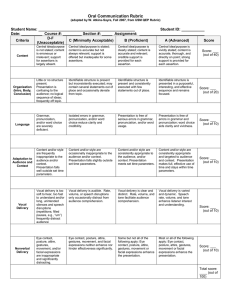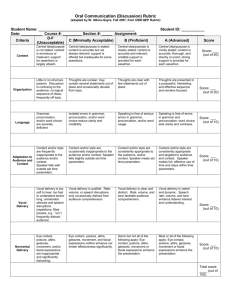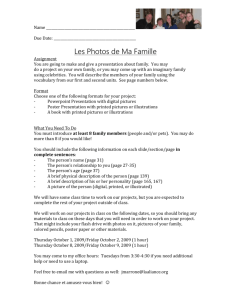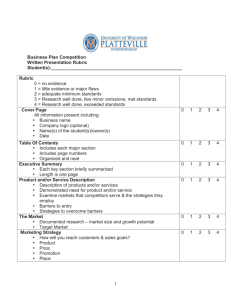Oral Communication Skills Rubric
advertisement
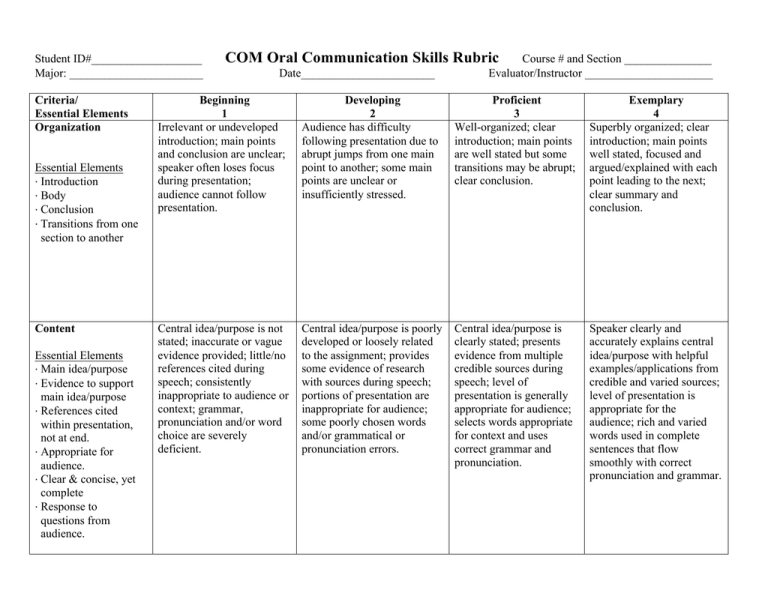
Student ID#___________________ Major: _______________________ Criteria/ Essential Elements Organization Essential Elements ·∙ Introduction ·∙ Body ·∙ Conclusion ·∙ Transitions from one section to another Content Essential Elements ·∙ Main idea/purpose ·∙ Evidence to support main idea/purpose ·∙ References cited within presentation, not at end. ·∙ Appropriate for audience. ·∙ Clear & concise, yet complete ·∙ Response to questions from audience. COM Oral Communication Skills Rubric Date_______________________ Course # and Section _______________ Evaluator/Instructor ______________________ Beginning 1 Irrelevant or undeveloped introduction; main points and conclusion are unclear; speaker often loses focus during presentation; audience cannot follow presentation. Developing 2 Audience has difficulty following presentation due to abrupt jumps from one main point to another; some main points are unclear or insufficiently stressed. Proficient 3 Well-organized; clear introduction; main points are well stated but some transitions may be abrupt; clear conclusion. Exemplary 4 Superbly organized; clear introduction; main points well stated, focused and argued/explained with each point leading to the next; clear summary and conclusion. Central idea/purpose is not stated; inaccurate or vague evidence provided; little/no references cited during speech; consistently inappropriate to audience or context; grammar, pronunciation and/or word choice are severely deficient. Central idea/purpose is poorly developed or loosely related to the assignment; provides some evidence of research with sources during speech; portions of presentation are inappropriate for audience; some poorly chosen words and/or grammatical or pronunciation errors. Central idea/purpose is clearly stated; presents evidence from multiple credible sources during speech; level of presentation is generally appropriate for audience; selects words appropriate for context and uses correct grammar and pronunciation. Speaker clearly and accurately explains central idea/purpose with helpful examples/applications from credible and varied sources; level of presentation is appropriate for the audience; rich and varied words used in complete sentences that flow smoothly with correct pronunciation and grammar. Criteria/ Essential Elements Supporting Materials/ Presentational Aids (Slides, posters, handouts, computergenerated materials, props, etc.) Essential Elements ·∙ Aids/materials support main point ·∙ Professional appearance ·∙ Clear & concise ·∙ Easily read & understood. Verbal and Non-Verbal Delivery Essential Elements ·∙ Voice volume & tone ·∙ Attire ·∙ Eye contact ·∙ Posture ·∙ Movement ·∙ Facial expressions ·∙ Audience engagement ·∙ Clear & concise Beginning 1 Few/no graphics used to enhance message or inappropriate graphics that are so poorly prepared that they detract from message; font is too small to be easily seen; presentational aids are unprofessional and poorly integrated into speech. Developing 2 Occasional use of graphics that rarely support message; choppy , time wasting multimedia; lacks smooth transition from one material to another; font is too small to be easily seen; Proficient 3 Graphics relate to and support message; font size is appropriate for reading; multimedia is informative and enhances the overall presentation, but not outstanding. Exemplary 4 Graphics used effectively to reinforce central idea and maximize audience understanding; varied media are used appropriately, not added simply for the sake of use; visuals are easily seen and read by even those in back of room; outstanding use of professional materials to accentuate main points with smooth transitions from one material to another. Verbal delivery is too soft or too fast, lacks confident tone; unintended silence, repeated words or sections and filled pauses (e.g. “um” or “you know”) or nonverbal cues (eye contact, posture, attire, movement or facial expressions) frequently distract audience. Vocal delivery is audible. Rate, volume or speech disruptions only occasionally distract from audience comprehension; eye contact, posture, attire, gestures, movement and facial expressions neither enhance nor hinder effectiveness significantly. Vocal delivery is clear and distinct. Rate, volume and tone facilitate audience comprehension. Some of the following enhance the presentation: eye contact, posture, attire, gestures, and movement or facial expressions. Vocal delivery is varied and dynamic. Speech rate, volume and tone enhance listener interest and understanding. Most or all of the following enhance the presentation: eye contact, posture, attire, gestures, and movement and/or facial expressions. Did student meet standard for outcome? Yes No Total points __________________ A wide range of sources were consulted during the creation of this rubric, including rubrics from Susan Hatfield’s “Sample Rubrics” page at http://course1.winona.edu/shatfield/air/rubrics.htm. 1/21/2014 tkc
